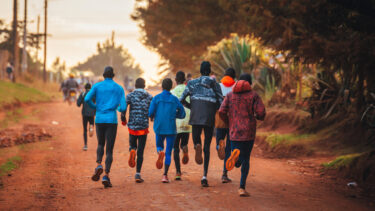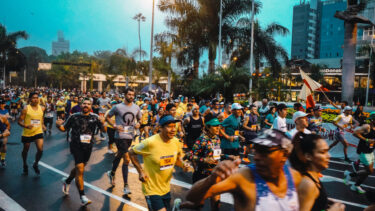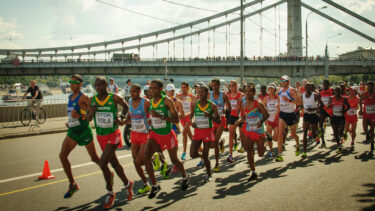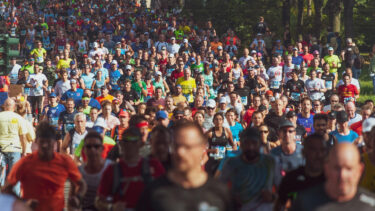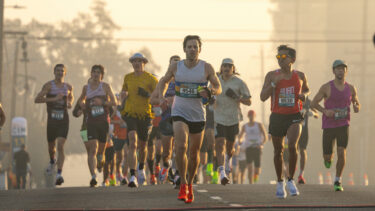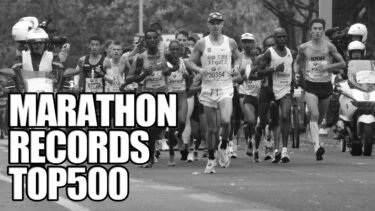This guide introduces 20 of the most popular full marathon races globally, many of which are part of the prestigious Abbott World Marathon Majors series. These events attract tens of thousands of runners, offering a diverse range of experiences from record-breaking courses to scenic city tours.

Top 20 Most Popular Full Marathon Races Worldwide
- New York City Marathon
- Location: New York, USA
- Features: One of the world’s largest citizen marathons, traversing all five boroughs of New York City.
- Participants: Over 50,000 (finishers)
- London Marathon
- Location: London, UK
- Features: Takes runners past iconic London landmarks like Tower Bridge and Buckingham Palace. Renowned for its significant charitable donations.
- Participants: Over 50,000 (finishers)
- Chicago Marathon
- Location: Chicago, USA
- Features: Known for its flat, fast course, making it popular for runners aiming for personal bests. Many world records have been set here.
- Participants: Over 40,000 (finishers)
- Berlin Marathon
- Location: Berlin, Germany
- Features: An exceptionally flat and fast course, often referred to as a “world record course” due to the numerous records set here.
- Participants: Approximately 40,000 (finishers)
- Paris Marathon
- Location: Paris, France
- Features: Starts near the Arc de Triomphe and offers picturesque views of the Eiffel Tower.
- Participants: Approximately 40,000
- Tokyo Marathon
- Location: Tokyo, Japan
- Features: Asia’s largest marathon, featuring a popular course that takes runners through iconic parts of Tokyo.
- Participants: Approximately 30,000
- Boston Marathon
- Location: Boston, USA
- Features: The world’s oldest marathon. It’s an elite race requiring strict qualifying times for entry.
- Participants: Approximately 30,000
- Honolulu Marathon
- Location: Honolulu, Hawaii, USA
- Features: No time limit, making it enjoyable for both beginners and veterans. Attracts a large number of Japanese participants.
- Participants: Over 20,000
- Seoul International Marathon
- Location: Seoul, South Korea
- Features: A course that winds through Seoul’s historic sites.
- Participants: Approximately 25,000
- Los Angeles Marathon
- Location: Los Angeles, USA
- Features: A popular race that tours major Los Angeles tourist attractions.
- Participants: Over 20,000
- Walt Disney World Marathon
- Location: Orlando, Florida, USA
- Features: A unique course running through Walt Disney World, with support from Disney characters.
- Participants: Approximately 26,000 (full marathon)
- Amsterdam Marathon
- Location: Amsterdam, Netherlands
- Features: Offers beautiful canal-side scenery and a fast course.
- Participants: Tens of thousands
- Rotterdam Marathon
- Location: Rotterdam, Netherlands
- Features: A flat course conducive to fast times, attracting many runners.
- Participants: Tens of thousands
- Dubai Marathon
- Location: Dubai, UAE
- Features: Known for its substantial prize money.
- Participants: Tens of thousands (total participants including half marathon, etc., are high)
- Shanghai Marathon
- Location: Shanghai, China
- Features: Runs through Shanghai’s modern cityscape.
- Participants: Tens of thousands
- Mexico City Marathon
- Location: Mexico City, Mexico
- Features: A challenging course due to its high altitude.
- Participants: Tens of thousands
- Sydney Marathon
- Location: Sydney, Australia
- Features: Passes iconic landmarks like the Opera House and Harbour Bridge.
- Participants: Tens of thousands (expected to join World Marathon Majors in 2025)
- Gold Coast Marathon
- Location: Gold Coast, Australia
- Features: A flat and easy-to-run course.
- Participants: Tens of thousands (total participants including other race categories are high)
- Cape Town Marathon
- Location: Cape Town, South Africa
- Features: Africa’s only IAAF Gold Label race.
- Participants: Tens of thousands
- Rome Marathon
- Location: Rome, Italy
- Features: A course that takes runners past ancient Roman ruins and historic buildings.
- Participants: Tens of thousands
These races each have their unique characteristics that draw runners from all over the world. Please note that participant numbers can vary by year, so the figures above are approximate.
Which Marathon is Best for You? Based on “Participant Numbers” and “Ease of Running”!
Key factors in choosing a marathon are “how many runners participate” and “how easy the race is to run.” Here, we’ve classified races in a matrix based on the following criteria for “ease of running”:
- Course Flatness: Flatter courses are easier to run.
- Climate: Moderate temperatures (not too hot, not too cold).
- Crowd Density: Not overly crowded (though this can be unavoidable in large events, it’s relative).
- Time Limit: Relatively lenient, beginner-friendly.
Considering these factors, we classify races into four categories using two axes: participant numbers and ease of running.
World Full Marathons: Participant Numbers vs. Ease of Running Matrix
| Very High Participation | High Participation | |
| Very Easy (Flat course/Good climate/Relatively long limits/Easy-going atmosphere) | 1. Large, Fast & Easy-Running Races –Berlin Marathon: Extremely flat, fast course. Ideal for setting records. –Chicago Marathon: Flat, fast course. Ideal for setting records. –Honolulu Marathon: No time limit. Warm climate, but early start avoids midday heat. Popular for beginners. –Amsterdam Marathon: Flat and easy to run. –Rotterdam Marathon: Flat, fast course. –Gold Coast Marathon: Flat with relatively good climate. –Dubai Marathon: Very flat. However, climate can be hot. | 2. Medium to Large, Fast & Easy-Running Races (Includes some races from above that may have slightly lower participant numbers in certain years or due to specific factors) –Sydney Marathon: Relatively new, expected to gain more popularity with World Marathon Majors entry, but the course is relatively easy to run. –Shanghai Marathon: Relatively flat. Considered easy to run for an urban marathon. |
| Easy-going atmosphere (May have some challenge or tighter time limits) | 3. Large, Challenging Races –New York City Marathon: Many bridges with ascents/descents, challenging. World’s largest in terms of participants. –London Marathon: Flat but with many curves and often crowded. –Tokyo Marathon: Urban marathon with many flat sections, but also some ascents/descents and high crowd density. –Paris Marathon: Historical landmarks mean cobblestones and some ascents/descents. –Los Angeles Marathon: Traverses urban areas, so has ascents/descents. –Roma Marathon: Many historical cobblestones and ascents/descents. | 4. Medium to Large, Challenging Races –Boston Marathon: Features “Heartbreak Hill” and other scents/descents, strict ualifying standards. A historically prestigious race. –Mexico City Marathon: Held at high altitude, making it very challenging. –Cape Town Marathon: Scenic but with some challenging ascents/descents. –Seoul International Marathon: Urban course with some ascents/descents. –Walt Disney World Marathon: Flat, but character greetings can lead to time loss (not ideal for fast times). |
Major marathons like those in the World Marathon Majors series (Tokyo, London, Chicago, Berlin, New York) and popular races like Honolulu need vast start and finish areas and courses to accommodate their high participant numbers. This naturally leads to relatively flat urban areas being chosen.
While courses like the New York City Marathon, with its many bridge ascents and descents, are considered “challenging,” this refers to elevation changes within a city. It’s different from the continuous hills like “Heartbreak Hill” in the Boston Marathon or the “high altitude” of Mexico City.
Conversely, truly “challenging” courses (e.g., steep mountainous areas, very hot desert regions) often cannot accommodate such large numbers of participants due to safety and operational concerns.
Therefore, the combination of “over 50,000 participants” and “very easy to run” or “relatively easy to run” is closely linked in today’s major global marathons.Highly Competitive Full Marathon Races with High Lottery Odds
The most sought-after and competitive full marathon races are primarily those in the Abbott World Marathon Majors (WMM) series. Gaining entry through a lottery can be extremely difficult.
Below are approximate lottery odds for major races. These odds fluctuate annually, so it’s always best to check official websites or current year statistics for the most accurate numbers.
Full Marathon Races with High Lottery Odds
- London Marathon
- Odds: Approximately 25-30 times (general lottery entry)
- Features: Known for having by far the highest lottery odds among the World Marathon Majors. There’s no standard time entry for non-UK residents, making general lottery, high-cost charity entries (requiring substantial donations), or official marathon tours the main options. Some runners report never getting selected even after entering for a decade.
- Tokyo Marathon
- Odds: Approximately 10-12 times (general lottery entry)
- Features: Asia’s largest citizen marathon and highly popular as an urban race. General lottery odds consistently remain high, making it a “platinum ticket” for citizen runners.
- New York City Marathon
- Odds: Approximately 6-25 times (general lottery entry)
- Features: One of the world’s largest citizen marathons. Past information has shown winning probabilities of 18% (approx. 5.5 times) or even lower at 4% (25 times), indicating significant year-to-year variation. Lottery categories may also differ based on residency (NYC residents, US residents, international residents).
Other Major Marathons
- Boston Marathon
- Lottery Entry: None
- Features: There is no lottery concept. You cannot even apply unless you meet strict qualifying standards (Boston Qualifier, BQ). Furthermore, even if you meet the BQ and apply, if there are too many applicants, runners are selected by fastest time, often resulting in a “cut-off time” faster than the BQ. It’s dubbed the “Marathon of the Chosen,” with the most stringent entry requirements.
- Berlin Marathon
- Odds: Approximately 3 times (general lottery entry)
- Features: Highly popular as a fast course where many world records have been set, but general lottery odds are relatively lower compared to other Majors. Entry is also possible via qualifying times or official marathon tours.
- Chicago Marathon
- Odds: Approximately 2 times (general lottery entry)
- Features: A flat, fast course conducive to good times. It’s said to have the lowest lottery odds among the World Marathon Majors, making it relatively easier to enter. Entry is also possible via qualifying times or official marathon tours.
The London Marathon stands out for its extremely high lottery odds, followed by the Tokyo Marathon and New York City Marathon. The Boston Marathon is unique in that it doesn’t have a lottery, but rather a very high barrier to entry based on strict qualification.
If you aim to participate in these races, you should consider various routes beyond the general lottery, such as charity entries (requiring significant donations), official marathon tours (at a higher cost), or meeting time qualifications (requiring very fast times).
Major Full Marathon Races with Strict Qualifying Times
Excluding the Olympics and World Athletics Championships, the following full marathon races have particularly strict qualifying times. These events serve as goals for runners seeking a high level of competition.
- Boston Marathon
- Features: The world’s oldest marathon, with no lottery entries whatsoever. Only runners who have met the strict qualifying standards (Boston Qualifying Time, BQ) for their age and gender are eligible to participate. Furthermore, even if you clear the BQ and apply, if there are too many applicants, runners are selected by fastest time, often resulting in a “cut-off time” even faster than the BQ. It is known as the “Marathon of the Chosen” and is a goal for many citizen runners.
- Example Qualifying Times (Men):
- 18-34 years: 2 hours 55 minutes
- 40-44 years: 3 hours 10 minutes
- (Note: For the 2026 race, standards have been announced to be 5 minutes stricter across the board.)
- Fukuoka International Marathon
- Features: A highly historic and prestigious race for male marathon runners in Japan, with extremely strict qualifying times. It’s not a race for casual citizen runners but for “chosen runners” with high-level records. It is also notable for being a men-only event.
- Example Qualifying Criteria (from 2024 race guidelines):
- Group A Marathon: Within 2 hours 27 minutes
- Group B Marathon: Within 2 hours 35 minutes
- (Note: Among applicants within these limits, approximately the top 500 records are selected. Qualifications from half marathon and 30km road races are also accepted.)
- Tokyo Marathon – Elite/Semi-Elite Categories
- Features: While the general lottery has very high odds, strict qualifying times are set for elite and semi-elite categories. These categories often come with additional conditions, such as being a registered athlete with the Japan Association of Athletics Federations.
- Example Elite Men: Marathon within 2 hours 21 minutes, Half Marathon within 1 hour 1 minute, 10,000m within 28 minutes, demanding records close to national records.
- Example Semi-Elite (RUN as ONE – Tokyo Marathon):
- Men: Within 3 hours
- Women: Within 3 hours 40 minutes
- (Note: May vary by year.)
- Beppu-Oita Mainichi Marathon
- Features: One of Japan’s major male marathon races, with relatively strict time qualifications for entry.
- Example Qualifying Criteria: Full marathon within 3 hours 30 minutes (men and women, though primarily a men’s race in focus).
- (Note: Specific categories may have further subdivided capacities and times.)
- Hofu Yomiuri Marathon
- Features: A men’s marathon race also with time restrictions for entry.
- Example Qualifying Criteria: Full marathon within 2 hours 40 minutes (for Category 1).
- (Note: Times vary by category.)
- Berlin Marathon – Fast Runners Category
- Features: While the lottery odds are relatively lower, the Fast Runners (semi-elite) category allows entry without a lottery but requires strict times.
- Example Fast Runners (2023):
- Men 44 years and under: 2 hours 45 minutes
- Women 44 years and under: 3 hours 10 minutes
- If you meet these times, you can gain preferential entry.
Beginner-Friendly Full Marathon Races with Lenient or No Time Limits and Relatively Flat Courses
Here are full marathon races with very lenient or no time limits and relatively flat courses, making them particularly recommended for beginners whose main goal is to finish.
- Honolulu Marathon – Honolulu, Hawaii, USA
- Features: Famously has no time limit, making it accessible to anyone from beginners to veterans. The course is generally flat with only gentle inclines. Held in tropical Hawaii, the climate is warm, but an early morning start helps avoid midday heat. Aid stations are well-equipped, and it attracts many Japanese runners.
- Beginner-Friendly Points: No time limit, warm climate, excellent support, and opportunities for tourism.
- Gold Coast Marathon – Gold Coast, Queensland, Australia
- Features: Known for its extremely flat and linear course. Runners enjoy beautiful coastal views, and the race is held during a cooler period, making it a comfortable run. The time limit is also relatively generous, making it a popular choice for personal best attempts or marathon debuts.
- Beginner-Friendly Points: Very flat course, comfortable climate, beautiful scenery, relatively long time limit.
- Walt Disney World Marathon – Orlando, Florida, USA
- Features: A unique course that winds through the Walt Disney World Resort, with a time limit of about 7 hours. The course is generally flat and offers high entertainment value, including character greetings and passing through attractions. Recommended for beginners who want to enjoy the experience and simply finish the race.
- Beginner-Friendly Points: Flat course, high entertainment value, relatively long time limit.
- NAHA Marathon – Okinawa, Japan
- Features: Strongly characterized as a citizen’s marathon, with a relatively generous time limit of 6 hours 15 minutes. While the course has some ups and downs, the roadside support is exceptionally warm, creating a welcoming atmosphere. Local delicacies offered at aid stations are also popular, allowing runners to enjoy a festive mood while aiming to finish.
- Beginner-Friendly Points: Longer time limit, warm roadside support, festive atmosphere.
- Seoul Marathon – Seoul, South Korea
- Features: A relatively flat course that goes through Seoul city, with a time limit of 5 hours. It attracts many participants and is considered relatively easy to run for an urban marathon. Held in early spring, the weather is often stable.
- Beginner-Friendly Points: Relatively flat urban course, comfortable climate (spring race).
- Frankfurt Marathon – Frankfurt, Germany
- Features: Known for its historic finish inside an indoor track, the course is very flat. The time limit is 6 hours. While known as a fast course, many citizen runners also participate, and the environment is well-suited for finishing. Held in autumn, the climate is often good.
- Beginner-Friendly Points: Very flat course, comfortable climate, relatively long time limit.
These races are particularly recommended for runners who prioritize finishing and enjoying the race atmosphere over competing for time.
These world-renowned full marathon events offer not just a race, but a unique opportunity to immerse yourself in the local culture, history, and vibrant atmosphere.
From challenging, fast courses that demand strict qualifying times to races with no time limits where you can simply enjoy the scenery and atmosphere, there’s a diverse range of events to suit every runner’s goals and ability.
Indeed, they are truly “running journeys” that continue to captivate runners worldwide. Why not find the perfect race for you and take the first step toward a new challenge?


